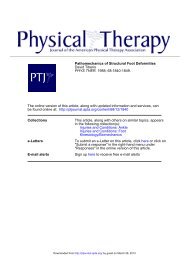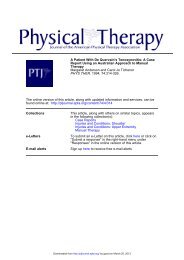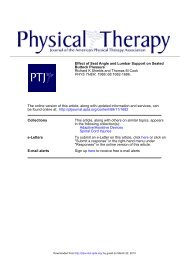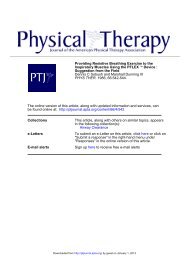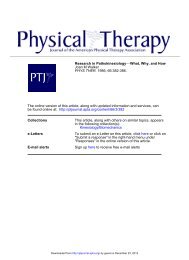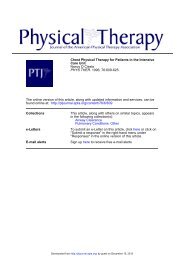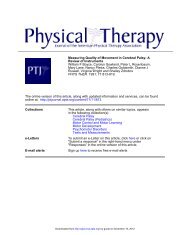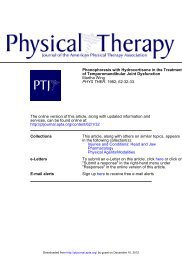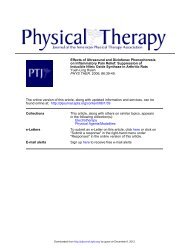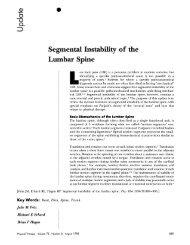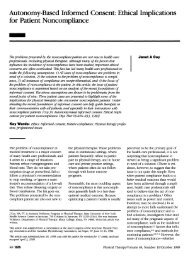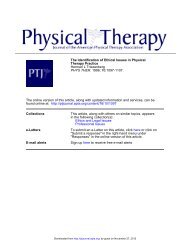Hemiplegic Shoulder Pain - Physical Therapy
Hemiplegic Shoulder Pain - Physical Therapy
Hemiplegic Shoulder Pain - Physical Therapy
Create successful ePaper yourself
Turn your PDF publications into a flip-book with our unique Google optimized e-Paper software.
sive elevation and are a likely cause of<br />
impingement.<br />
An important question to be addressed<br />
is how much ROM is "enough."<br />
All medical professionals seem "programmed"<br />
to take each joint through its<br />
full ROM. As previously noted, complete<br />
ROM to a young physical therapist<br />
is not necessarily complete ROM to a<br />
geriatric stroke patient. Perhaps a more<br />
realistic goal is the maintenance of painfree<br />
functional ROM in the shoulder.<br />
The affected arm must be pain free to<br />
serve even in an assistive role. 38 Functional<br />
ROM has been defined as flexion<br />
to 100 degrees, abduction to 90 degrees,<br />
lateral rotation to 30 degrees, and medial<br />
rotation to 70 degrees. 90<br />
Another aspect to be considered is<br />
whether abduction should be included<br />
in passive exercise, in view of its tendency<br />
to cause soft tissue impingement.<br />
Some authorities recommend that abduction<br />
should be performed only in the<br />
scapular plane, that is, 30 degrees to 40<br />
degrees from the frontal plane, 3,34 because<br />
lateral rotation is not required to<br />
prevent impingement. 27 Curtailing the<br />
amplitude of passive abduction in exercise<br />
programs might preserve functional<br />
ROM and minimize impingement pain.<br />
If impingement during ROM is determined<br />
to be the etiological factor in<br />
pain, then the amplitude of passive motion<br />
should be kept within the pain-free<br />
range. 15 Caldwell et al reported that pain<br />
subsided in 43% of their patients with<br />
HSP when the amplitude of passive<br />
ROM was limited. 15<br />
Should the patient begin to complain<br />
of pain during passive ROM, a thorough<br />
evaluation to assess the cause of pain<br />
should be conducted before pain and<br />
stiffness become established.<br />
Diagnosis of Established <strong>Pain</strong>ful<br />
Conditions<br />
If a patient has an established painful,<br />
stiff shoulder, the first step in treatment<br />
is the identification of the cause. A carefully<br />
detailed medical history is important<br />
to determine the prestroke history<br />
of any shoulder pathological conditions<br />
and to identify any known trauma that<br />
occurred after the stroke, such as<br />
falls. 23,27 A correct diagnosis of the cause<br />
is essential if the patient is to be helped."<br />
A thorough diagnostic examination of<br />
the neck and shoulder should be conducted<br />
to identify cervical spine pathological<br />
factors, rotator cuff or biceps<br />
brachii tendinitis, or GHJ or acromioclavicular<br />
joint arthritis. 42,99 Confirmatory<br />
evidence of rotator cuff tears and<br />
adhesive capsulitis can be obtained with<br />
arthrography. Radiographs can rule out<br />
humeral fracture 3 and ectopic ossification.<br />
105 Electrophysiological studies can<br />
be used to identify brachial plexus injurv.<br />
<strong>Shoulder</strong>-hand syndrome may be<br />
confirmed by a positive response to stellate<br />
ganglion block. 58<br />
Conservative Management<br />
If subluxation is identified as the causative<br />
agent, several treatment methods<br />
exist. <strong>Pain</strong> and stiffness in a subluxated<br />
shoulder, however, are not necessarily a<br />
result of subluxation. 15,102 Krempen et al<br />
examined 37 patients with pain and subluxation<br />
and found 16 patients had<br />
other, orthopedic causes for the pain."<br />
Conservative orthopedic management<br />
of patients with diagnoses of tendinitis,<br />
bursitis, and rotator cuff tears is<br />
similar. The goals of treatment are pain<br />
reduction and improvement of ROM.<br />
Symptoms may be reduced with oral<br />
anti-inflammatory agents and analgesics<br />
and injections of lidocaine and steroids<br />
into trigger points, the subacromial bursae,<br />
or the joint space. 27,28,42,106 As pain<br />
decreases, active, passive, and assistive<br />
exercises are used to improve ROM.<br />
Applications of heat, cold, phonophoresis,<br />
and transcutaneous electrical<br />
nerve stimulation may be effective in<br />
relieving pain and encouraging motion.<br />
106 Applications of heat, however,<br />
have not been proven to be of particular<br />
benefit in the treatment of HSP. Liao et<br />
al found no significant difference in the<br />
amount of improvement in ROM between<br />
patients treated with exercise only<br />
versus those treated with a combination<br />
of heat and exercise therapy; exercise<br />
appeared to be the most effective treatment.<br />
4 Thus far, in studies of hemiplegic<br />
patients with unstated etiologic factors<br />
of pain, ultrasound 22 and TENS 6 have<br />
not been found to decrease pain or to<br />
contribute to increased range of shoulder<br />
motion.<br />
If an injury to the upper trunk has<br />
been diagnosed, the brachial plexus<br />
must be protected until regeneration can<br />
occur. 53 The shoulder should be splinted<br />
in 45 degrees of abduction, a treatment<br />
similar to that of postsurgical repair of<br />
the upper trunk. 107 Care must be taken<br />
to prevent further traction injury until<br />
regeneration occurs. The prognosis for<br />
recovery of function varies widely. 23<br />
Although evidence exists that adhesive<br />
capsulitis in nonhemiplegic patients<br />
is a self-limited disease resolving in one<br />
to three years, (see the article by C. T.<br />
Wadsworth in this issue), the same does<br />
not appear to be true of hemiplegic adhesive<br />
capsulitis. 12,42 A vigorous program<br />
of ice or heat applications and<br />
active and passive exercises can be combined<br />
with anti-inflammatory and analgesic<br />
medications, oral corticosteroids,<br />
and muscle relaxants. 41 Suprascapular<br />
nerve blocks, 108 corticosteroid injections<br />
into trigger points, and stellate ganglion<br />
blocks have been reported to be beneficial.<br />
23<br />
Antispasmodic medications may supplement<br />
inhibition and relaxation techniques.<br />
16 Motor-point blocks of the<br />
trapezius 16 and pectoralis major 109,110<br />
muscles may aid in controlling spasticity.<br />
In the management of SHS, early recognition<br />
is the key to a favorable prognosis;<br />
prompt treatment is essential to<br />
prevent permanent disability. 58,60,111 An<br />
aggressive exercise program is an essential<br />
component of treatment. 27,59 Active<br />
muscle contraction and joint movements<br />
are important, as are light weightbearing<br />
activities. Exercise must be performed<br />
within the pain-free range and<br />
frequently for short periods during the<br />
day. Modalities such as heat or ice treatments<br />
or TENS may be used to increase<br />
sensory input and reduce pain. 28,71,112<br />
Although TENS has been reported as<br />
helpful in the management of reflex<br />
sympathetic dystrophies, no research results<br />
appear to be reported on the effectiveness<br />
of TENS in hemiplegic SHS.<br />
Aggressive and prompt management<br />
of hand edema is important, because<br />
prolonged edema will precipitate perhaps<br />
irreversible hand stiffness. 27 Dependent<br />
positions of the hand should be<br />
avoided; an elevated position is preferable.<br />
Intermittent pneumatic compression<br />
may be of value in reducing hand<br />
edeipa, 23,90,113 and an elastic glove is<br />
helpful also in controlling edema. 71<br />
Systemic administration of corticosteroids<br />
for two to three weeks is recommended<br />
by several authorities for the<br />
management of SHS. 27,59,71 Davis et al<br />
reported a complete resolution of symptoms<br />
in 68 hemiplegic patients using<br />
oral steroids in combination with an<br />
intensive rehabilitation program. 57 A<br />
sympathetic block followed by intensive<br />
rehabilitation is cited as the most effective<br />
treatrnent by Some researchers.<br />
58,61,111 Sympathectomy is suggested<br />
in refractory cases. 58,59,111<br />
The emotional state of patients with<br />
severe HSP has been described as tense,<br />
hyperresponsive to pain, overemotional,<br />
apathetic, and emotionally dependent. 23<br />
Whether such emotional states contrib-<br />
1890 PHYSICAL THERAPY<br />
Downloaded from<br />
http://ptjournal.apta.org/ by guest on December 15, 2012




